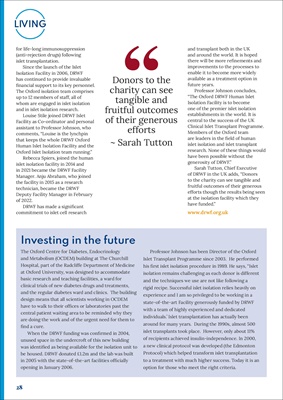
28
LIVING
for life-long immunosuppression
(anti-rejection drugs) following
islet transplantation.
Since the launch of the Islet
Isolation Facility in 2006, DRWF
has continued to provide invaluable
financial support to its key personnel.
The Oxford isolation team comprises
up to 12 members of staff, all of
whom are engaged in islet isolation
and in islet isolation research.
Louise Stile joined DRWF Islet
Facility as Co-ordinator and personal
assistant to Professor Johnson, who
comments, "Louise is the lynchpin
that keeps the whole DRWF Oxford
Human Islet Isolation Facility and the
Oxford Islet Isolation team running."
Rebecca Spiers, joined the human
islet isolation facility in 2014 and
in 2021 became the DRWF Facility
Manager. Anju Abraham, who joined
the facility in 2015 as a research
technician, became the DRWF
Deputy Facility Manager in February
of 2022.
DRWF has made a significant
commitment to islet cell research
Investing in the future
The Oxford Centre for Diabetes, Endocrinology
and Metabolism (OCDEM) building at The Churchill
Hospital, part of the Radcliffe Department of Medicine
at Oxford University, was designed to accommodate
basic research and teaching facilities, a ward for
clinical trials of new diabetes drugs and treatments,
and the regular diabetes ward and clinics. The building
design means that all scientists working in OCDEM
have to walk to their offices or laboratories past the
central patient waiting area to be reminded why they
are doing the work and of the urgent need for them to
find a cure.
When the DRWF funding was confirmed in 2004,
unused space in the undercroft of this new building
was identified as being available for the isolation unit to
be housed. DRWF donated £1.2m and the lab was built
in 2005 with the state-of-the-art facilities officially
opening in January 2006.
Professor Johnson has been Director of the Oxford
Islet Transplant Programme since 2003. He performed
his first islet isolation procedure in 1989. He says, "Islet
isolation remains challenging as each donor is different
and the techniques we use are not like following a
rigid recipe. Successful islet isolation relies heavily on
experience and I am so privileged to be working in a
state-of-the-art Facility generously funded by DRWF
with a team of highly experienced and dedicated
individuals.' Islet transplantation has actually been
around for many years. During the 1990s, almost 500
islet transplants took place. However, only about 11%
of recipients achieved insulin-independence. In 2000,
a new clinical protocol was developed (the Edmonton
Protocol) which helped transform islet transplantation
to a treatment with much higher success. Today it is an
option for those who meet the right criteria.
and transplant both in the UK
and around the world. It is hoped
there will be more refinements and
improvements to the processes to
enable it to become more widely
available as a treatment option in
future years.
Professor Johnson concludes,
"The Oxford DRWF Human Islet
Isolation Facility is to become
one of the premier islet isolation
establishments in the world. It is
central to the success of the UK
Clinical Islet Transplant Programme.
Members of the Oxford team
are leaders in the field of human
islet isolation and islet transplant
research. None of these things would
have been possible without the
generosity of DRWF."
Sarah Tutton, Chief Executive
of DRWF in the UK adds, "Donors
to the charity can see tangible and
fruitful outcomes of their generous
efforts though the results being seen
at the isolation facility which they
have funded."
www.drwf.org.uk
Donors to the
charity can see
tangible and
fruitful outcomes
of their generous
efforts
~ Sarah Tutton